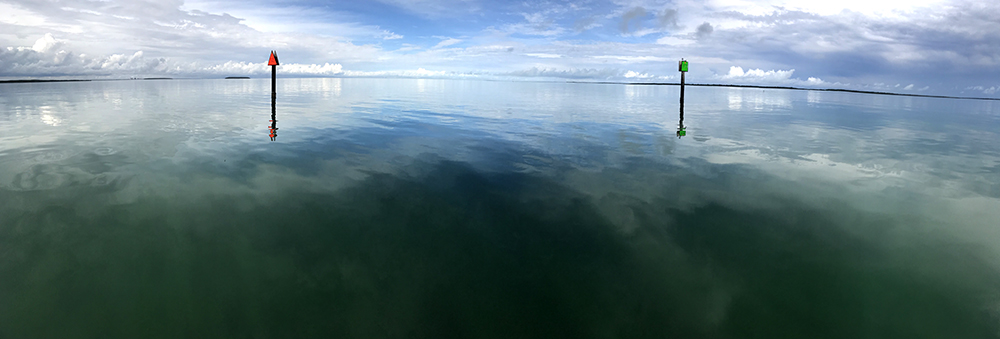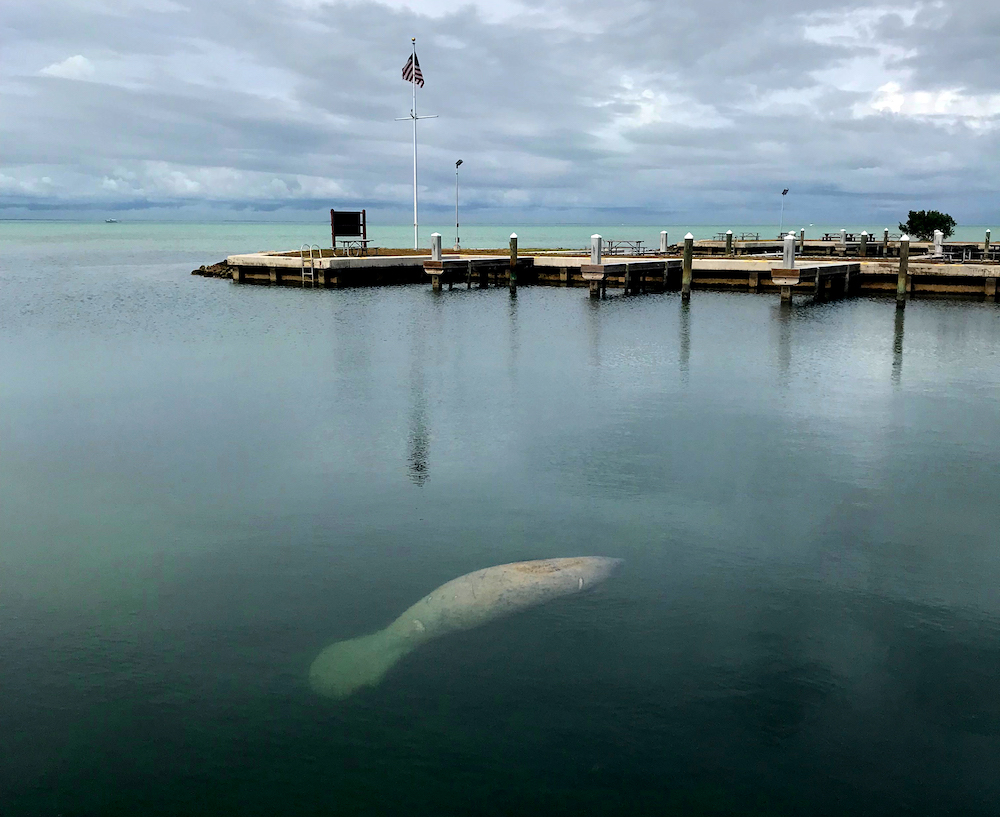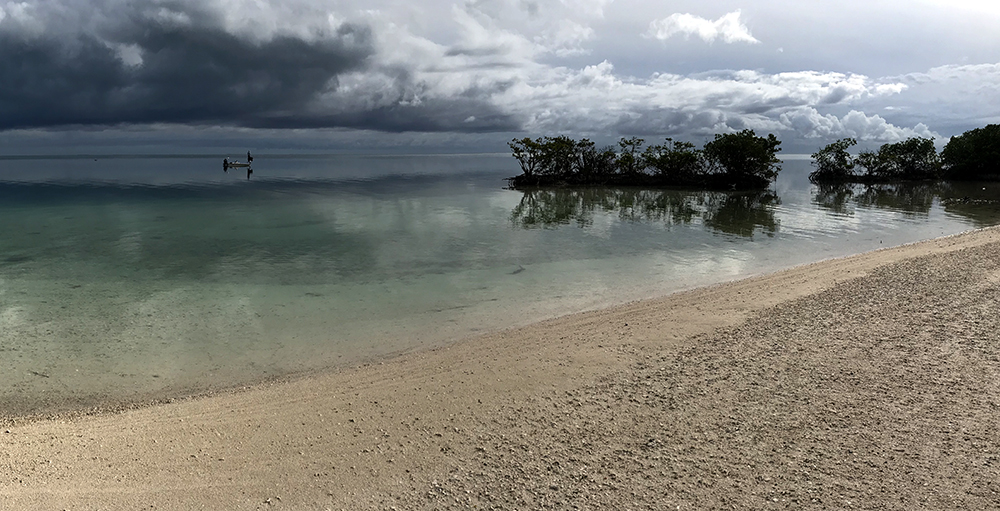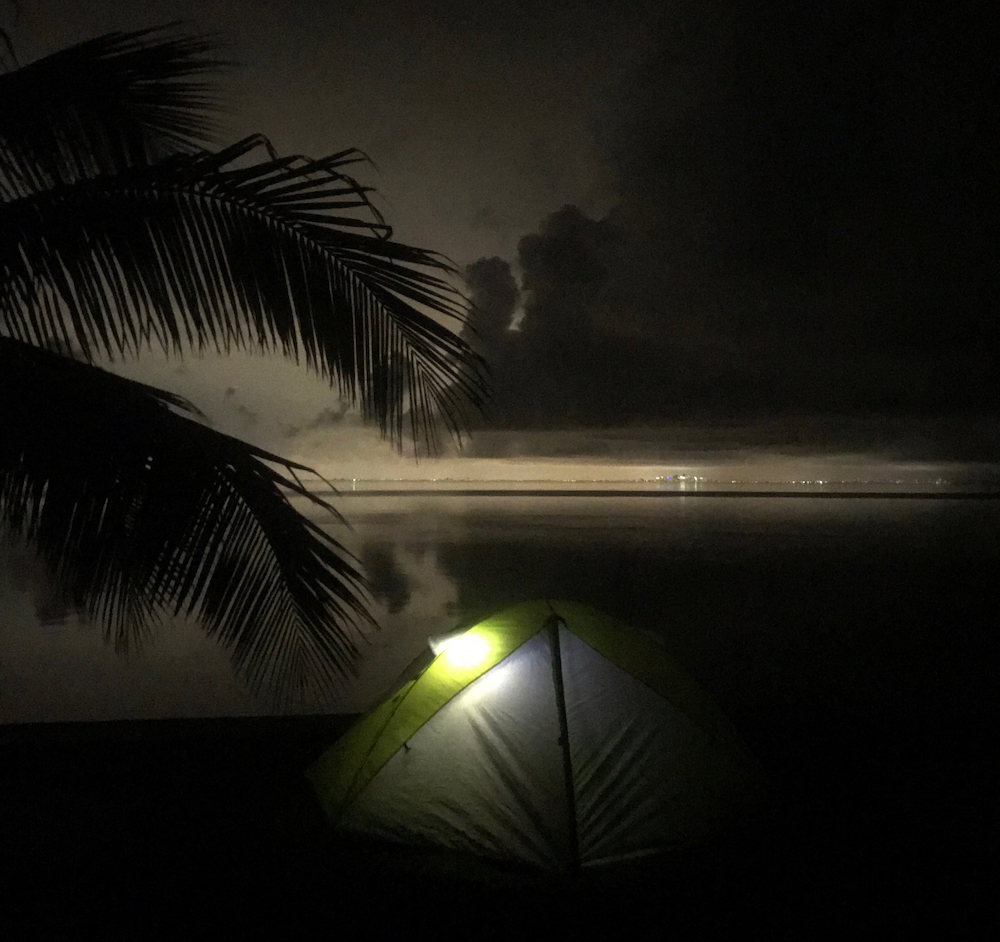There is really no denying it, Biscayne National Park is a world-class aquatic wonderland. With more than 95% of its 172,000 acres covered by the sparkling waters of Biscayne Bay, visitors must take to the sea in order to kindle a lasting relationship with this nautical national park.

Guide to Biscayne
Biscayne National Park
Although this somewhat obscure park may not resinate with average park-goers as a household name, Biscayne holds a unique position in the ranks of our national parks.
No other park in the country can lay claim to the third largest coral reef in the world, which lies adjacent to the longest undeveloped shoreline on the east coast of Florida. Not many other parks brag of hosting secluded tropical beaches with crystal clear turquoise waters that teem with some five hundred species of fish, five species of sea turtles along with dolphin, barracuda, manatee and sea urchins.
Now keep in mind, this is all found within sight of the Magic City of Miami, Florida, which holds some cool attractions of its own.
Where is Biscayne National Park
Biscayne National Park is situated in the southern waters of the larger Biscayne Bay, which lies just offshore of Miami, Florida. The park is mostly underwater, but there are a number of small offshore islands, known as “keys” which lie about 7 to 8 miles east of the coastal mainland. These islands offer the opportunity to sightsee, camp, picnic or perhaps even hike, although the mosquitoes may put an immediate damper on the latter option.
Exploring Biscayne
Despite the fact that Biscayne is conveniently located just a stone’s through from the Magic City, making your way out to enjoy the park’s stellar scenery can be a bit of a hassle, unless of course you came equipped with your own flats fishing boat. The park is comprised of 40 small mangrove islands, which lie surrounded by the relatively shallow waters of Biscayne Bay.

It helps to have some form of plan when rolling into Biscayne without a boat. It should be noted that the term “boat”, will mean a motorboat for most visitors. While experienced sea-kayakers with proper equipment may enjoy the seven-mile crossing from the mainland to Boca Chita or Elliot key, many landlubbing travelers will want no part of it. And those who roll in with a canoe are simply asking for a nightmare, so just avoid that death sentence before you begin.
Dante Fascell Visitor Center
The Dante Fascell Visitor Center is the obvious first stop for most park visitors. Here guests can obtain information about guided boat tours, watch the park film, hit up a ranger program, or just chill along the jetty and watch boats sail by on the bay. Many locals use this area as a gathering spot for family barbecues and for easy access to good fishing on the north side of the parking lot.
The visitor center features an artist’s gallery where contemporary artists can display works that feature the surrounding landscape. Numerous shows are held throughout the year and interested visitors should see who’s works will be displayed during their visit to the Dante Fascell Visitor Center Gallery.
Most guided boat tours will depart from the Dante Fascell Visitor Center, but a few will leave from other areas. Be sure to understand where your trip will depart well in advance. See the Park Junkie Biscayne Activities Page for more info on these tours.
Boca Chita Key
Perhaps one of the most unmistakeable scenes in all of our national parks can be found on Boca Chita Key, the park’s most visited island. This doesn’t mean the average tourist will be able to name it upon viewing its photo… But you’re not an average tourist…
You’re a Park Junkie, and once you know the Boca Chita Lighthouse & its tropical surroundings, you’ll always recognize it. It is incredibly picturesque, and is situated in the most memorable of settings.

The 65-foot-tall lighthouse was constructed by early 20th century electronics mogul Charles Honeywell in the 1930s. It was designed more as a novelty item than an actual guiding beacon to ships in the night. Honeywell, who bought Boca Chita Key in 1937, used to throw parties on the island, and the lighthouse offered a classic backdrop for extravagant events for the social elite of the day.
These days, campers count sheep below the lighthouse while camping on the small, scenic island. Visitors have the opportunity to access the lighthouse viewing deck and a fantastic view of the surrounding tropical waters and the Miami skyline during daytime hours if a park ranger is on duty. Check with the visitor center to inquire about this option.

The island has a sizable dock that accommodates both smaller boats and larger yachts, with winter weekends witnessing full docks by noon. Most of these boats will be weekend day-trippers, as Boca Chita is sort of a party destination for local waterborne folk in nearby Miami.
The evenings slow down a bit, and most of the local traffic leaves by 1700 hours (5pm) as there are dock fees after this hour for camping. Larger vessels should be aware that the channel into the dock is shallow, and only measures about 4′ at low tide.
Aside from camping, the island offers a dockside picnic shelter, and a number of tables in the clearing around the lighthouse. A short, half-mile hiking trail is found to the east of the restrooms, which leads to the south end of the island and a view of the Lewis Cut and the desolate Sands Key, which is narrowly separated by Elliot Key by Sands Cut.
Elliot Key
For those who want a bit of island adventure during their visit, Elliot Key may hold your cup of tea. This is the park’s largest key provides the park’s longest trail, the Spite Highway, which believe it or not, is often a tough trail, due to the prevalence of the ever-present mosquito.
This historic trail was constructed out of malice toward the park idea by a bunch of angry land developers who had plans to build a community of high-rise condos on the islands just prior to President Lyndon Johnson’s October 18, 1968 declaration, which made this collection of keys a national monument. Those interested can read all about the Spite Highway in the History of Biscayne section.

This unique path leads down the center of the island for six miles, and offers the best wildlife viewing options in the park… of course, the most encountered wildlife along this route will likely be mosquitoes, so be prepared for these little beasts before you get to the island. Check out the activities page to find out more about the Spite Highway, and its bizarre history.
Elliot Key has a campground, picnic tables, and a dock with 33 boat slips where manatee can often be seen. Restrooms and cold-water showers are available, and pets are allowed in the park’s developed areas, but must be restrained with a leash at all times. Bring a fishing pole and a valid Florida salt-water license for a shot a some good shoreline casting and a possible big fish story for your friends who are stuck back in the real world.
Stiltsville
This outlaw haven was once the center of illicit activities out on Biscayne Bay. From rum-running, to gambling, prostitution and drug running, Stiltsville became a well-known and frequent location of interest for law-enforcement officials in Miami.
Back in 1933, a fellow named “Crawfish” Eddie Walker built a shack elevated above the shallow waters by an assemblage of wooden stilts. Here he sold fishing bait and beer, along with his soon-to-be-famous chilau, or crawfish chowder.
His little domicile was the first of a number of such structures, which lay just outside the city’s jurisdiction, just over one mile offshore. During the community’s heyday in the 1960s, there were 27 structures stretching above the surrounding waters.
Stiltsville attracted more than just the brazen and the rebellious of Miami’s social strata. Lawyers, bankers, doctors and politicians somehow found their ways to places such as The Calvert Club, The Quarterdeck Club, Party Central and The Bikini Club, which gave free drinks to ladies wearing skimpy bikinis.
Florida Governor LeRoy Collins was known to frequent the small collection of shacks, and wrote to his resident-friend Jimmy Ellenburg, that “When the time comes when I say so long to this life, I hope the great beyond seems alot like your cabin in the sea…”
Today, only a eight structures remain in Stiltsville, as the decades of hurricanes and sea life have taken their toll… All good things must end I suppose…
Visitors can still visit the remnants of this once great destination, although the level of enjoyment may be significantly less from what it would have been 70 years ago…
The remaining structures are managed by the Stiltsville Trust, which may offer access to any one of seven structures on a permission-based arrangement. See their website for more information at StiltsvilleTrust.org.
What to do in Biscayne
Visitors to Biscayne will find no shortage of activities to occupy their time, especially if they’re into any form of aquatic pursuit. Boating, kayaking, fishing, bird watching, snorkeling and diving are common past times for many visitors, and this unique park can easily be described as a “world-class” destination for each of any of these activities.

There are fantastic opportunities for camping on Boca Chita Key, as well as Elliot Key. Hiking on the islands is limited, although for those that are immune to the bites of mosquitoes, the hiking on Elliot Key just can’t be beat… enjoy…
Guided tours offer most visitors their only shot at a truly involved experience inside the park. The Biscayne National Park Institute provides numerous tours of the park’s vast waterworld. Tours range from mellow bird & wildlife watching tours aboard a 45′ motorized catamaran, while others involve more adventurous experiences aboard seafaring sailboats.

Opportunities to paddleboard, snorkel and swim amoung the park’s islands are available on a number of these tours. See the Park Junkie Biscayne Activities Page for a full roundup of the fun stuff you can do on such tours.
Park Junkie Verdict
As I have mentioned above, this park requires a plan, and resources necessary to implement that plan. For those without access to a boat, the park’s secrets may remain hidden. There are endless opportunities to enjoy the small coves and a boat will certainly help facilitate a more adventurous and independent visitor experience.
My journeys in Biscayne have been nothing less than fascinating. I was fortunate enough to talk my buddy Alan into taking his boat out there from Key Largo a few years back, to camp on Boca Chita Key. Accompanied by his girlfriend Judy, we embarked on a three-day camping trip during the month of January.
The weather was perfect, with temperatures just chilly enough to keep the bugs down, but warm enough to provide nice evenings at camp despite the lack of a campfire, which are prohibited at all sites except at Elliot Key’s group site.
Gazing at the Miami skyline silhouetted against the night sky from a solitary camp on Boca Chita Key lends an unforgettable memory, days spent boating into the dark recesses of an endless series of mangrove coves on my kayak while schools of dolphin act as an eager escort simply cannot be described as any less than spectacular.

Another visit provided the opportunity to climb aboard a 46 Morgan ketch and sail out to keys on the Biscayne Institute’s Sail, Snorkel, Paddle Trip. This daylong journey may not leave one feeling like Robinson Crusoe, but it nonetheless allows those lacking watercraft the ability to experience the park’s gorgeous post-card-worthy world of water for a modest fee.
Biscayne National Park is an amazing destination. There really isn’t anything quite like it in the national park club and it is truly unique addition to the park idea. Undoubtedly, these waters effortlessly showcase the diversity of the national park experiment and any true park junkie will not regret taking the steps necessary to experience this watery wonderland.
See ya there…
Guide to Biscayne
Relevant Links
Biscayne National Park Institute
National Park Guides

All content found on Park Junkie is meant solely for entertainment purposes and is the copyrighted property of Park Junkie Productions. Unauthorized reproduction is prohibited without the express written consent of Park Junkie Productions.
YOU CAN DIE. Activities pursued within National Park boundaries hold inherent dangers. You are solely responsible for your safety in the outdoors. Park Junkie accepts no responsibility for actions that result in inconveniences, injury or death.
This site is not affiliated with the National Park Service, or any particular park.
